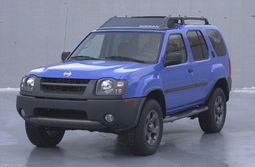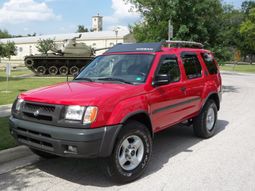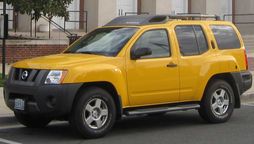The History Of Nissan Xterra

The Nissan Xterra is a compact SUV based on the Nissan F-Alpha platform as of the 2005 model year, and shares many similarities with the Nissan Frontier pickup. All Xterras are currently built in Smyrna, Tennessee and São José dos Pinhais, Brazil. It is called the Nissan Roniz in Iran where it is also built under licence by Pars Khodro, and is built and sold in China as the Paladin. The Xterra was named after the XTERRA series of off-road triathlon races. Nissan was the race series' primary sponsor until the end of 2006.
The Xterra was originally introduced in North America in the 2000 model year and was marketed as a simple, but capable SUV with the slogan Everything you need, nothing you don't. Although accepted by a wide range of ages, incomes, lifestyles and genders, Nissan marketed the Xterra primarily to the adventurous and outdoor consumer. Many commercials feature one driving the vehicle through mud, unloading mountain bikes out of the back, or packing up surfing equipment. Two design cues have remained constant through the vehicle's life, its raised rear roofline and the 'Hump' on the back lift gate. The raised roof allows for stadium seating and the hump allowed the inclusion of a first aid kit in the liftgate. The Xterra was not sold in Europe or Japan, where the smaller X-Trail and now Qashqai are Nissan's entries in the compact SUV segment. In the United States, the Xterra was Nissan's entry-level SUV until the arrival of the 2008 Nissan Rogue. In the Nissan lineup, the Xterra is priced between the Rogue and the Murano, but sized below the Rogue.
2000–2001
During its first two years, there were three Xterra models. The two base models were designated XE, though those letters did not appear on the exterior name plate. The Xterra was mounted on a truck frame, as contrasted with the unibody Pathfinder.
The lowest-price model came with the 4 cylinder KA24DE motor similar to the ones found in the Nissan Altima and 240SX, manual transmission only, steel wheels, and lacked accessories such as the step rails and a roof rack.
The most popular XE Xterras were configured with several option packages, combining the 3.3L V6 with other features such as the roof rack, side step-rails, and carpeted floormats. The XE proved to be the most popular of the trim levels, with more flexibility on equipment options. A fully loaded XE had almost all the practical features of the top-of-the-line SE model, while costing an average of $2,000 less.
The SE was the premium trim level for the Xterra. Everything which was an option on the XE came standard on the SE. Nissan, to set apart a fully-optioned XE and the SE added a flip-up sunroof and special badging to the back of the truck ("Xterra SE" rather than just "Xterra"). Other SE-only options included the fuzzy upholstery, and 6-CD changer.
Several "minor" options were available from the dealer, such as mudflaps, cargo liners, and in-cabin ventilation microfilters. It was the only generation to bear Nissan's 1980s-2001 logo until its 2002 facelift.
2002–2004
Xterra was freshened for 2002. The interior received a redesigned dash and center console, while the biggest changes were to the top-of-the-line powerplant and the front end. In 2001 Nissan restyled the front end of the Frontier aggressively and added overhead clearance in the engine bay. In 2002 Nissan brought similar changes to the Xterra, including Nissan's new 210 hp 3.3-liter Roots Type Supercharger V6. Nissan's current logo was added to the grille.
Color was also revised in 2002. Aztec Red and Kaki were dropped, while Shock Blue, Sedona, and Molten Lava were introduced. Atomic Orange was later added, but proved short lived. In addition, the audio systems were upgraded. The premium audio system, a 6-disc AM/ FM/ CD with 6 speaker setup, was replaced with a 300W Rockford Fosgate AM/ FM/ CD system with 8 speakers and a large subwoofer that took up a portion of the rear storage area.
2005–present
In 2005, the Xterra was redesigned on a new platform shared by the Nissan Titan and Nissan Frontier. The new model is larger in all dimensions than its predecessor. Utilizing Nissan's 4.0L VQ40DE engine, it produces 265hp (198kW). The new engine is an improvement upon Xterra's previous powerplant, more refined and incorporating variable valve timing. Available with a rear differential locker on the off-road model, the Xterra competes with other SUVs of its size. The Xterra will get a facelift for 2009 with more options, colors, leather seats on SE models, and roof mounted lights on off-road models.
- 2000 Motor Trend's Sport Utility of the Year
- 2000 North American Truck of the Year
- 2000 New England Motor Press Association's Winter Vehicle Award of New England for Best in Class - Mini Sport Utility
- 2001 Named Top Car by AAA New Car and Truck Buying Guide
- 2005 Named on the Automobile Magazine's 50 Great New Cars list
- 2006 Nominated as North American Truck of the Year
- 2006 Motor Trend's Sport Utility of the Year
- 2006 Motor Trend's Truck Trend's Best Little-Guy SUV Award
- 2006 Car and Driver Rock-Hopper SUV Winner.
- 2006 4x4 of the Year award from Peterson's 4-Wheel and Off-Road magazine.
- 2006 Edmunds.com Editor's Most Wanted Vehicle
- 2009 4Wheeler Magazine's SUV of the Year
From Wikipedia, the free encyclopedia
More About Nissan Xterra




|